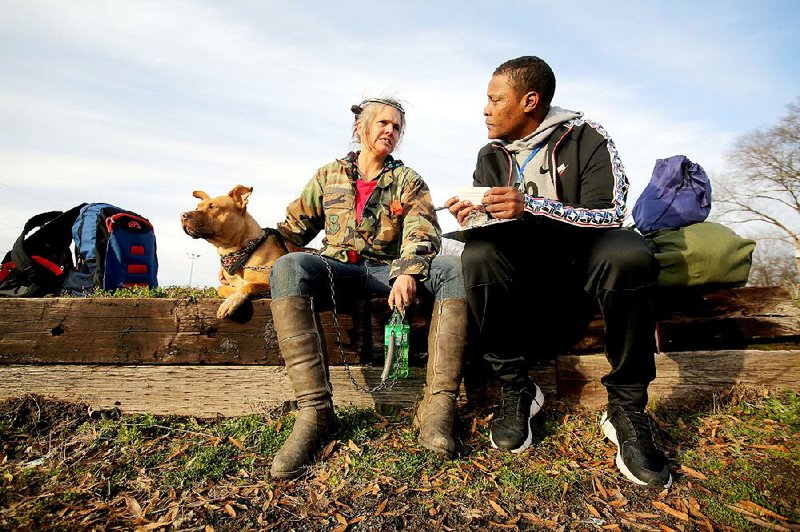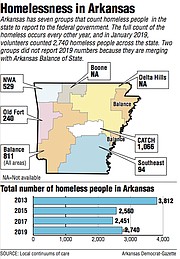Arkansas' homeless population rose by just over 10% from 2017-19, according to the most recent data from five regional groups across the state.
The population of people experiencing homelessness during a 24-hour sample period in January increased from 2,451 in 2017 to 2,740 in 2019, according to regional reports and interviews with officials.
Arkansas' total population in 2018 was slightly more than 3 million, of which about 479,000 were considered living below the federal poverty level.
Over the past decade, homelessness has been trending downward nationally. But during the past couple of years, it's increased slightly, according to the National Alliance to End Homelessness.
Advocates for the homeless and others said they're working to alleviate the state's problem by coordinating services such as mental health care, housing and substance abuse counseling.
"I think you have a lot of providers doing good work; however, they're doing it in silos," said Fredrick Love, president of Central Arkansas Team Care for the Homeless. "Once we begin to coordinate our services, ... I think we are going to be able to begin to decrease that number."
The central Arkansas group covers Lonoke, Pulaski, Prairie and Saline counties. It had the highest number of homeless people at 1,066, according to a report on the biennial count.
Each state is divided into what are called continuums of care, which recruit volunteers to conduct "point-in-time" counts of the homeless every other year. Arkansas had seven continuums during the previous full count, although Boone, Baxter, Marion and Newton Counties Continuum of Care and Delta Hills Continuum of Care did not conduct counts in 2019 because they are merging with the Arkansas Balance of State continuum.
Full counts, which include those who are living in camps or on the streets, occur every other year. Counts of only those staying in shelters occur between full counts.
Continuums report the number to the U.S. Department of Housing and Urban Development, which uses the information to help determine how much money to allot for regional homelessness programs.
The Central Arkansas Team Care for the Homeless, also called CATCH, is working to create a coordinated entry system, which allows organizations to track and share information on the homeless in the area, Love said.
In a coordinated entry system, workers interview homeless individuals when they first visit a shelter to learn details about them, including what resources they need. Providers can then more efficiently connect the homeless with the appropriate service.
Love, who was elected CATCH president earlier this year, said he also hopes to reach out to more groups -- both homeless service providers and others who are not "traditional providers," such as local hospitals, that often come into contact with the homeless.
"You will have a lot of different resources come to bear on this issue, and I believe that the result will be great," Love said. "But you know, you have to coordinate those services."
The Northwest Arkansas Continuum of Care already has a coordinated entry system, said Steve Burt, its executive director.
The Northwest Arkansas group counted 529 people in 2019, up from 330 in 2017. The reason for the increase is "difficult to pinpoint," Burt said, but he added that he's seen an increase in mental health issues among the homeless.
There's a need for affordable housing, he said, and his organization is talking with nearby housing authorities about instituting a homeless preference for applicants to some programs.
A study completed earlier this year by the National Low Income Housing Coalition, a Washington, D.C.-based advocacy and research group, showed that no state has enough affordable housing for low-income residents.
The study showed that Arkansas has about 56 homes available for every 100 of the lowest-income renters.
"It's difficult to pull yourself up by the bootstraps," Burt said.
In the coming months, the group hopes to end homelessness among military veterans. Burt said that since he began work on the coordinated entry system, the number of veterans and their families who are homeless has dropped from more than 100 to 31 as of the end of July.
Arkansas Balance of State, which encompasses the most counties of any continuum in Arkansas, counted the second-most-number of homeless people in the state -- 811 people.
Sue Legal, the president of the group, said via email that a goal for future counts is to better track the number of unaccompanied children. The 2018 count of homeless people staying in shelters found zero unaccompanied youths.
But after the Ouachita Children's Center Inc. started a street outreach program and day shelter for homeless youths, the staff in Garland County reported 145 unsheltered youths. Outside of Garland County, where the outreach efforts began in 2018, workers found only one homeless child without shelter, Legal said.
"If the city of Hot Springs has found 145, and we know that is not even a drop in the bucket for the number of homeless youth who are actually on the streets, I am sure there are more than one other within the entire Balance of State region," Legal said.
The Old Fort Homeless Coalition counted 240 people.
The Southeast Arkansas Continuum of Care had the fewest with 94 people. President Norma Payne said only one agency that participated in the count conducted a street count. The rest counted only the homeless people in their shelters.
Metro on 08/04/2019

